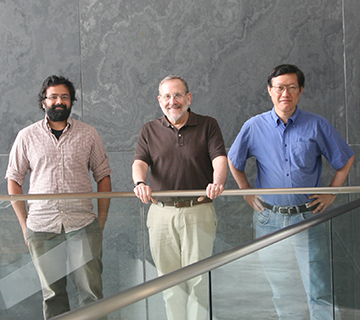The retina is not only a light sensor but also a sophisticated image processor. Photoreceptors (rods and cones) generate electrical signals when illuminated, much like pixels in a camera. They form connections (synapses) with interneurons, which process the information and transmit it to retinal ganglion cells (RGCs). Around 70 types of interneurons make specific synapses on at least 30 types of RGCs, each of which thereby becomes specialized to respond to a visual feature, such as motion in a particular direction, edges, or color contrasts. The RGC axons then project through the optic nerve, sending these 30 parallel images of the world to the rest of the brain for further analysis.
In a recent paper, Arjun Krishnaswamy, Masa Yamagata and colleagues studied one particular type of RGC, called the “W3B” cell, which performs a fascinating computation called “object motion sensing.” In a previous study, the group showed that W3B-RGCs respond when a small object moves relative to a differentially moving background but not when the entire visual field moves together (Zhang et al., PNAS, 2012). The cells can thereby distinguish moving objects in a visual scene even if the scene is also moving on the retina – for example, because of head or eye movements. They may help us to see sudden movement by small objects against the backdrop of a moving world –for example, a hawk flying overhead.
In the new paper, Krishnaswamy et al. used genetically engineered mouse lines to identify W3B-RGCs and a number of possible input cells so they could stimulate and record from them. Of all the interneurons investigated, they found that one type, called VG3, provides remarkably strong input to the W3B-RGCs. What was surprising about this connection is that it represents a detour in an otherwise direct path from photoreceptor to RGC. Most RGCs are two synapses away from a photoreceptor, but with the addition of VG3s, object motion detectors are three synapses away. They speculate that this seemingly cumbersome arrangement helps W3B-RGCs distinguish local from distant motion. The argument is that signals about distant motion take more time to reach the W3B-RGCs than signals about nearby motion, so a delay line helps both signals arrive at the same time, aiding precise comparison.
Krishnaswamy and colleagues then investigated how this unusual circuit develops. They found that both VG3 and W3B cells express a gene called Sidekick-2 that Yamagata had discovered several years ago and shown to be present at specific subsets of synapses (Yamagata and Sanes, Nature, 2008). Sidekick-2 is a so-called homophilic adhesion molecule, meaning that Sidekick-2 molecules bind to each other. In this case, when the Sidekick-2 gene is deleted, the number and strength of the synapses that VG3 cells make on W3B-RGCs is drastically reduced, preventing the W3B-RGCs from computing object motion. More generally, the results on Sidekick-2 provide a way of thinking about how the proper pre- and postsynaptic elements find each other in the crowded neuropil of the developing brain. Sidekick is a member of a large family of related molecules called “immunoglobulin superfamily molecules,” and it will now be important to ask whether other family members play similar roles at other synapses.


